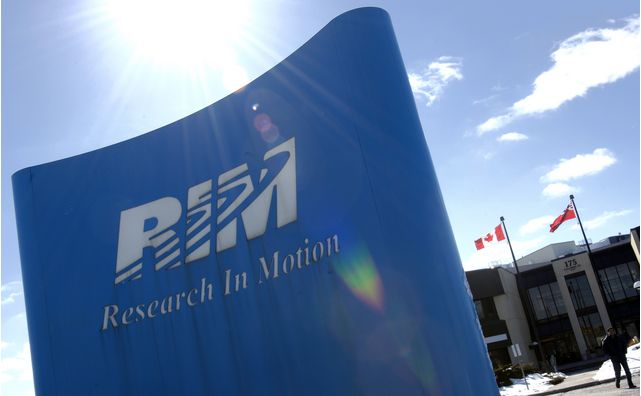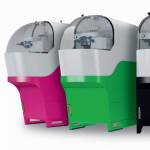BlackBerry Creator Lazaridis Puts $100 Million Into Nano Labs
Mike Lazaridis, whose invention of the BlackBerry smartphone more than a decade ago redefined the way people send e-mail, is drawing inspiration from the early days of computing for his next act.
Backed by his $100 million donation, the Mike & Ophelia Lazaridis Quantum-Nano Centre opens tomorrow in Waterloo, Ontario, aiming to recreate the conditions that made AT&T Inc.’s Bell Labs a hive of technological innovation in the early 1960s and laid the groundwork for the success of Silicon Valley.
The new research center is designed to produce breakthroughs in the science and technology of things approaching the size of an atom. It’s “absolutely” going to be the Bell Labs of the 21st century, Lazaridis said yesterday in a telephone interview. “That reality got clearer and clearer to me as we got closer to the ribbon-cutting.”
Lazaridis, who resigned as chairman of struggling BlackBerry maker Research In Motion Ltd. (RIMM) in January, says he’s now devoting most of his time to help get the Quantum-Nano Centre off the ground and to form a cluster of cutting-edge research with the decade-old Institute for Quantum Computing andPerimeter Institute for Theoretical Physics, both founded with a total of more than $250 million of his own money and additional funds he helped raise.
The facilities will be enough to lure the brightest minds in the field to Canada, Lazaridis said.

No Mountains
“We can’t offer them ocean, beaches or mountains, but we can try and offer them the best environment, the best collaborators, the best equipment that would be conducive to them making the breakthroughs of their lifetime,” Lazaridis said. “One of the best ways to describe this is we’re trying to break the known laws of physics.”
The technology Lazaridis is talking about is designed to redefine the boundaries of Moore’s Law, the principle — associated with Intel Corp. (INTC) co-founder Gordon Moore — that the number of transistors that can be placed on an integrated circuit doubles every two years. Quantum computing and nanotechnology would allow medicine to be delivered to individual cells, could create minute energy sources and could even produce self-healing materials that could be used in a nuclear power plant, he says.
“It’s getting more and more difficult to make smaller devices as we approach the size of an atom, but it’s also getting more expensive to build those devices,” he said. “You know you’re at the limit when those two things happen. The only way we can break through those barriers is quantum computing.”
Possible Investments
While Lazaridis said he’s considering investments in nano and quantum technology, he wouldn’t say when or how much he’ll invest. The 51-year-old still owns 29.7 million shares in RIM, which are worth about $214 million, according to an April filing.
“I do have the funds to invest in both angel and venture capital, but I’m being very, very strategic,” he said.
While Waterloo does have some local venture capital that startups can tap, it lacks the billion of dollars in venture capital that investors are willing to risk in Silicon Valley on local startups. That doesn’t faze Lazaridis, the son of Greek immigrants who immigrated to Canada as a boy and started RIM while still at the University of Waterloo in the 1970s.
“The venture capital will find its way to those individual entrepreneurs or companies that are interested in commercializing these discoveries,” he said.
Valley’s Roots
Bell Labs, founded in 1925 and now part of Alcatel-Lucent, had its operations in New York City and the New Jersey suburbs, an area that hasn’t been able to seize the mantle of technological innovator held by California’s Silicon Valley, home to Intel, Apple Inc. and Google Inc. Bell Labs alumni such as William Shockley helped bring the research center’s innovations to the West Coast.
In Waterloo, other companies are championing the growth of the technology industry as RIM continues to shrink, with users switching to devices from Apple and Samsung Electronics Co.
Desire2Learn Inc., a local online-education software startup, raised $80 million in venture funding this month from investors including Menlo Park, California-based New Enterprise Associates Inc. Waterloo-based OpenText Corp., a 20-year-old maker of business software, saw revenue grow 17 percent to $1.21 billion in its most recent fiscal year and employs more than 4,500 workers worldwide.
The two provide a morale boost to the local economy as RIM cuts 5,000 jobs to try to return to profitability. Chief Executive Officer Thorsten Heins, who took over in January, is counting on a new lineup of phones, due next year, to reverse the company’s fortunes.
Lazaridis, who remains on the board of RIM and runs its innovation committee, says he still regularly consults with Heins, who he picked as his successor.
While he declined to say if he’s happier being able to devote himself full-time to pure science and philanthropy rather than running RIM, he said he’s enjoying his new project.
“Never in my wildest dreams did I think I would be part of this adventure,” he said. “I wouldn’t have it any other way.”
By Hugo Miller
Source:http://www.bloomberg.com








